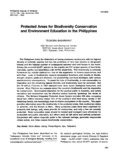Protected areas for biodiversity conservation and environment education in the Philippines
Share
Abstract
The Philippines holds the distinction of having enormous biodiversity with the highest density of endemic species but has the problem of very fast decline in old-growth forests and the highest number of endangered mammal and bird faunas in the world. Among the recorded 53,577 species in the country are 512 unique species of land birds, mammals, reptiles and amphibians with 43-73% endemicity. This biodiversity is seriously threatened by habitat destruction due to the expansion of human population and activities. Loss of biodiversity impairs ecosystem functions and results in floods, drought, erosion, pests and diseases, low productivity, and food shortages, with serious socioeconomic consequences. To arrest the loss of biodiversity, in situ conservation is imperative and the remaining natural habitats and biodiversity must be protected. Bu the 73 million Filipinos in 1997 demand more land, water, biological resources, and income. Most Filipinos are unaware about the country's biodiversity and the imperative for conservation. Environment education for the general public is essential, and the nature recreation and ecotourism can be effective means towards "greening" the minds of citizens. The National Integrated Protected Areas System includes 290 sites occupying about four million hectares (about 13% of the countrys' total land area), mostly in the remaining forests, but increasingly more in marine ecosystems in the country. This paper provides information about the biodiversity in the protected areas, their ecotourism status or potential, and the threats to them. Many protected areas have been exploited for products and energy, only some provide for ecotourism, and only a few are actually protected. Some accessible areas should be funded and managed more effectively for ecotourism and public education, but others must be left alone and actively protected. Encounter with nature engender pride in the national heritage, generates responsible citizen action, and helps ensure biodiversity conservation.
Suggested Citation
Bagarinao, T. (1999). Protected areas for biodiversity conservation and environment education in the Philippines. Philippine Journal of Science , 128(3), 191-209. http://hdl.handle.net/10862/1613
Subject
Collections
- AQD Journal Articles [1249]

